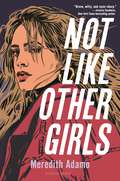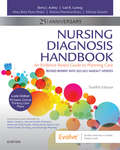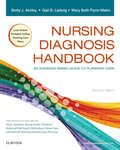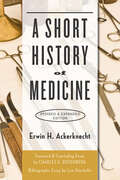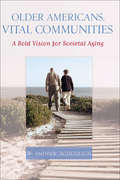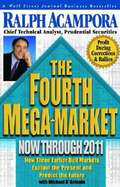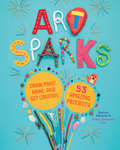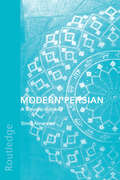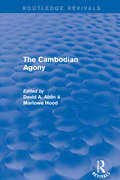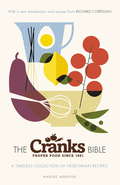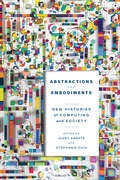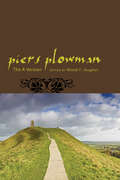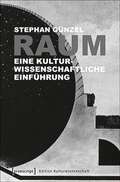- Table View
- List View
Not Like Other Girls
by Meredith Adamo“Powerful, brilliantly plotted, voicey, gripping, beautiful, heart-wrenching, hilarious . . . Read this book.” -Liz Lawson, New York Times bestselling author of The AgathasWhen Jo-Lynn Kirby 's former best friend-pretty, nice Maddie Price-comes to her claiming to be in trouble, Jo assumes it's some kind of joke. After all, Jo has been an outcast ever since her nude photos were leaked-and since everyone decided she deserved it. There's no way Maddie would actually come to her for help.But then Maddie is gone.Everyone is quick to write off Maddie as a runaway, but Jo can't shake the feeling there's more to the story. To find out the truth, Jo needs to get back in with the people who left her behind-and the only way back in is through Hudson Harper-Moore. An old fling of Jo's with his own reasons for wanting to find Maddie, Hudson hatches a fake dating scheme to get Jo back into their clique. But being back on the inside means Jo must confront everything she'd rather forget: the boys who betrayed her, the whispers that she had it coming, and the secrets that tore her and Maddie apart. As Jo digs deeper into Maddie's disappearance, she's left to wonder who she's really searching for: Maddie, or the girl she used to be.Not Like Other Girls is a stunning debut that takes a hard look at how we treat young women and their trauma, through the lens of a missing girl and a girl trying to find herself again.
Nursing Diagnosis Handbook E-Book: An Evidence-Based Guide to Planning Care
by Betty J. Ackley Gail B. Ladwig Mary Beth Makic Marina Martinez-Kratz Melody ZanottiGet nursing care plans right! Ackley’s Nursing Diagnosis Handbook: An Evidence-Based Guide to Planning Care, 12th Edition helps practicing nurses and nursing students select appropriate nursing diagnoses and write care plans with ease and confidence. This convenient handbook shows you how to correlate nursing diagnoses with known information about clients on the basis of assessment findings, established medical or psychiatric diagnoses, and the current treatment plan. Extensively revised and updated with the new 2018-2020 NANDA-I approved nursing diagnoses, it integrates the NIC and NOC taxonomies, evidence-based nursing interventions, and adult, pediatric, geriatric, multicultural, home care, safety, and client/family teaching and discharge planning considerations to guide your students in creating unique, individualized care plans.Step-by-step instructions shows you how to use the Guide to Nursing Diagnoses and Guide to Planning Care sections to create a unique, individualized plan of care. UNIQUE! Provides care plans for every NANDA-I approved nursing diagnosisPromotes evidence-based interventions and rationales by including recent or classic research that supports the use of each intervention. Presents examples of and suggested NIC interventions and NOC outcomes in each care plan.150 NCLEX exam-style review questions are available on Evolve.Easy-to-follow sections I and II guide you through the nursing process and selection of appropriate nursing Appendixes provide you with valuable information in an easy-to-access location. Clear, concise interventions are usually only a sentence or two long and use no more than two references. Safety content emphasizes what must be considered to provide safe patient care. Classic evidence-based references promote evidence-based interventions and rationales.List of Nursing Diagnosis Index on inside front cover of book for quick reference. Alphabetical thumb tabs allow quick access to specific symptoms and nursing diagnoses.NEW! Includes comprehensive, up-to-date information on the new 2018-2020 NANDA-I approved nursing diagnoses, complete with 17 new diagnoses.NEW! and UPDATED! Provides the latest NIC/NO C, interventions, and rationales for every care planNEW! Section I: Gender identity discussion includes information about the caregiver’s responsibility for adapting care accordingly. NEW! Interventions reorganized by priority helps you quickly identify the information you’re searching for. NEW! Section II: Bullying, Gender Dysphoria, Medical marijuana, Military families/personnel, Opioid use/abuse, Service animals, Technology addiction, and Veterans.NEW! Additional clarification of use of QSEN throughout book in Section INEW! Concept map creator added from Yoost textbook. NEW! Updated rationales include evidence-based references 5 years or less.
Nursing Diagnosis Handbook - E-Book: An Evidence-Based Guide to Planning Care
by Betty J. Ackley Gail B. Ladwig Mary Beth MakicAckley’s Nursing Diagnosis Handbook: An Evidence-Based Guide to Planning Care, 11th Edition helps practicing nurses and nursing students select appropriate nursing diagnoses and write care plans with ease and confidence. This convenient handbook shows you how to correlate nursing diagnoses with known information about clients on the basis of assessment findings, established medical or psychiatric diagnoses, and the current treatment plan. Extensively revised and updated with the new 2015-2017 NANDA-I approved nursing diagnoses, it integrates the NIC and NOC taxonomies, evidence-based nursing interventions, and adult, pediatric, geriatric, multicultural, home care, and client/family teaching and discharge planning considerations to guide you in creating unique, individualized care plans.Comprehensive, up-to-date information on all the 2015-2017 NANDA-I nursing diagnoses so you stay in the know. UNIQUE! Provides care plans for every NANDA-I approved nursing diagnosis plus two unique care plans for Hearing Loss and Vision Loss.Includes pediatric, geriatric, multicultural, client/family teaching and discharge planning, home care, and safety interventions as necessary for plans of care. Presents examples of and suggested NIC interventions and NOC outcomes in each care plan. UNIQUE! Care Plan Constructor on the companion Evolve website offers hands-on practice creating customized plans of care.150 NCLEX exam-style review questions are available on Evolve.Promotes evidence-based interventions and rationales by including recent or classic research that supports the use of each intervention. Classic evidence-based references promote evidence-based interventions and rationales.Clear, concise interventions are usually only a sentence or two long and use no more than two references. Safety content emphasizes what must be considered to provide safe patient care. Step-by-step instructions show you how to use the Guide to Nursing Diagnoses and Guide to Planning Care sections to create a unique, individualized plan of care. List of Nursing Diagnosis Index in back inside cover of book for quick reference. Three-column index is easy to use. Easy-to-follow sections I and II guide you through the nursing process and selecting appropriate nursing diagnoses.Alphabetical thumb tabs allow quick access to specific symptoms and nursing diagnoses.
A Short History of Medicine
by Erwin H. Ackerknecht Lisa Haushofer.Erwin H. Ackerknecht;€™s A Short History of Medicine is a concise narrative, long appreciated by students in the history of medicine, medical students, historians, and medical professionals as well as all those seeking to understand the history of medicine.Covering the broad sweep of discoveries from parasitic worms to bacilli and x-rays, and highlighting physicians and scientists from Hippocrates and Galen to Pasteur, Koch, and Roentgen, Ackerknecht narrates Western and Eastern civilization;€™s work at identifying and curing disease. He follows these discoveries from the library to the bedside, hospital, and laboratory, illuminating how basic biological sciences interacted with clinical practice over time. But his story is more than one of laudable scientific and therapeutic achievement. Ackerknecht also points toward the social, ecological, economic, and political conditions that shape the incidence of disease. Improvements in health, Ackerknecht argues, depend on more than laboratory knowledge: they also require that we improve the lives of ordinary men and women by altering social conditions such as poverty and hunger.This revised and expanded edition includes a new foreword and concluding biographical essay by Charles E. Rosenberg, Ackerknecht;€™s former student and a distinguished historian of medicine. A new bibliographic essay by Lisa Haushofer explores recent scholarship in the history of medicine.
A Short History of Medicine
by Erwin H. Ackerknecht Lisa Haushofer.Erwin H. Ackerknecht;€™s A Short History of Medicine is a concise narrative, long appreciated by students in the history of medicine, medical students, historians, and medical professionals as well as all those seeking to understand the history of medicine.Covering the broad sweep of discoveries from parasitic worms to bacilli and x-rays, and highlighting physicians and scientists from Hippocrates and Galen to Pasteur, Koch, and Roentgen, Ackerknecht narrates Western and Eastern civilization;€™s work at identifying and curing disease. He follows these discoveries from the library to the bedside, hospital, and laboratory, illuminating how basic biological sciences interacted with clinical practice over time. But his story is more than one of laudable scientific and therapeutic achievement. Ackerknecht also points toward the social, ecological, economic, and political conditions that shape the incidence of disease. Improvements in health, Ackerknecht argues, depend on more than laboratory knowledge: they also require that we improve the lives of ordinary men and women by altering social conditions such as poverty and hunger.This revised and expanded edition includes a new foreword and concluding biographical essay by Charles E. Rosenberg, Ackerknecht;€™s former student and a distinguished historian of medicine. A new bibliographic essay by Lisa Haushofer explores recent scholarship in the history of medicine.
Older Americans, Vital Communities: A Bold Vision for Societal Aging
by W. Andrew AchenbaumThis thought-provoking work grapples with the vast range of issues associated with the aging population and challenges people of all ages to think more boldly and more creatively about the relationship between older Americans and their communities. W. Andrew Achenbaum begins by exploring the demographics of our aging society and its effect on employment and markets, education, health care, religion, and political action. Drawing on history, literature, and philosophy, Achenbaum focuses on the way health care and increases in life expectancy have transformed late life from a phase characterized by illness, frailty, and debility to one of vitality, productivity, and spirituality. He shows how this transformation of aging is beginning to be felt in programs and policies for aging persons, as communities focus more effort on lifelong learning and extensive civic engagement. Concerned that his own undergraduate students are too focused on the immediate future, Achenbaum encourages young people to consider their place in life's social and chronological trajectory. He calls on baby boomers to create institutional structures that promote productive, vital growth for the common good, and he invites people of all ages to think more boldly about what they will do with the long lives ahead of them.
The Fourth Mega-Market, Now Through 2011: How Three Earlier Bull Markets Explain the Present and Predict the Future
by Ralph Acampora Michael D'AngeloA proven leader in the financial world explains the current bull market--and how to profit from it--by comparing it to the great bull markets of the past.Were you surprised by Wall Street's incredible performance over the past few years? Ralph Acampora wasn't. In fact, Acampora, Prudential's top technical analyst, predicted the current bullish trend--and helped countless clients profit from it. Now you can too.Acampora coined the term mega-market to describe a bull market that lasts a minimum of ten years and a maximum of eighteen years with Dow gains of between 400% and 500%. In The Fourth Mega-Market, Acampora helps readers take advantage of the staggering performance of the current market by showing its similarities with the three previous mega-markets in American history. In an entertaining and straight-forward style, and with a wealth of informative charts and graphs, he helps readers recognize patterns that can explain market performance, showing how to use technical analysis to "hear the voices" of the market. He offers valuable tips, such as how to spot and protect yourself from a correction; how psychology and politics influence the market; and how to analyze the performance of various market segments. Finally, he makes exciting predictions on just where the market will go before it ends and how it will get there, giving specific recommendations. While today's information overload keeps us on the edge of our seats, scanning the numbers for subtle clues as to the market's next seismic shift, Ralph Acampora shows us the value of a larger perspective, one that not only explains today's mega-market, but also shows us how to keep investing our money wisely and ride high on the current wave.
Art Sparks: Draw, Paint, Make, and Get Creative with 53 Amazing Projects!
by Marion Abrams Hilary Emerson LayThis lively, colorful compendium of arts and crafts for a new generation of kids features projects specially designed to spark creativity, invite self-expression, and nurture self-confidence. From finger puppets to fabric flags to shrink art, each activity uses inexpensive materials and can be crafted in less than 90 minutes.
Modern Persian: A Course-Book
by Simin AbrahamsModern Persian begins with the teaching of the Persian alphabet. It aims to provide the student with the necessary skills for social interaction, as well as a basis for the study of modern literature. The course consists of seventeen units and favours teaching by communicative and contextual learning. Most units begin with a reading exercise used to introduce an item of grammar and new vocabulary, followed by explanations and drill exercises aimed at consolidating the student's understanding. Complete with Persian-English vocabulary to all the exercises and tape recordings, this is an up-to-date textbook which can be used both by teachers or individuals wishing to learn Persian independently.
Revival: The Cambodian Agony (1990)
by David A. Ablin M. HoodThis title was first published in 1990: Cambodia, it has been said, has gone through the most radical social upheaval and transformation of any country in recorded history. From the overthrow of Prince Sihanouk, who ruled for 29 year, in 1970 to the victory of the Cambodian Communist Party in 1975, Cambodia suffered massive saturation bombing and an unusually violent civil war. It is estimated that half a million people of the seven million total population died. From 1975 to the end 1978 as many as another three million perished because of the brutal policies of the government, and spurred the civil war that has been simmering ever since. In this book, the world's leading experts on Cambodia and the politics of Indochina address the major issues facing Cambodia since the overthrow of the Pol Pot regime in 1978.
The Cranks Bible: A Timeless Collection of Vegetarian Recipes
by Nadine AbensurA classic collection of healthy and delicious plant-based recipes from the Cranks kitchenSince opening their first restaurant in 1961, Cranks have been pioneers of vegetarian cuisine and champions of organic produce. Here, celebrated writer and chef Nadine Abensur presents over 200 classic meat-free recipes from the Cranks kitchen. From pumpkin and parsley risotto to aubergines with smoked ricotta, passion fruit ice-cream, walnut and raisin loaves and plum jam, every recipe is packed full of beautifully simple, natural ingredients that will nourish both body and soul. With advice on selecting the freshest seasonal produce, eating healthily and enjoying the experience of making mouth-watering food, THE CRANKS BIBLE is a celebration of vegetarian cooking and an essential resource for every home.
Abstractions and Embodiments: New Histories of Computing and Society (Studies in Computing and Culture)
by Janet Abbate Stephanie DickCutting-edge historians explore ideas, communities, and technologies around modern computing to explore how computers mediate social relations.Computers have been framed both as a mirror for the human mind and as an irreducible other that humanness is defined against, depending on different historical definitions of "humanness." They can serve both liberation and control because some people's freedom has historically been predicated on controlling others. Historians of computing return again and again to these contradictions, as they often reveal deeper structures.Using twin frameworks of abstraction and embodiment, a reformulation of the old mind-body dichotomy, this anthology examines how social relations are enacted in and through computing. The authors examining "Abstraction" revisit central concepts in computing, including "algorithm," "program," "clone," and "risk." In doing so, they demonstrate how the meanings of these terms reflect power relations and social identities. The section on "Embodiments" focuses on sensory aspects of using computers as well as the ways in which gender, race, and other identities have shaped the opportunities and embodied experiences of computer workers and users. Offering a rich and diverse set of studies in new areas, the book explores such disparate themes as disability, the influence of the punk movement, working mothers as technical innovators, and gaming behind the Iron Curtain. Abstractions and Embodiments reimagines computing history by questioning canonical interpretations, foregrounding new actors and contexts, and highlighting neglected aspects of computing as an embodied experience. It makes the profound case that both technology and the body are culturally shaped and that there can be no clear distinction between social, intellectual, and technical aspects of computing. Contributors: Janet Abbate, Marc Aidinoff, Troy Kaighin Astarte, Ekaterina Babinsteva, André Brock, Maarten Bullynck, Jiahui Chan, Gerardo Con Diaz, Liesbeth De Mol, Stephanie Dick, Kelcey Gibbons, Elyse Graham, Michael J. Halvorson, Mar Hicks, Scott Kushner, Xiaochang Li, Zachary Loeb, Lisa Nakamura, Tiffany Nichols, Laine Nooney, Elizabeth Petrick, Cierra Robson, Hallam Stevens, Jaroslav Švelch
Piers Plowman: The A Version
by Mí 267 Eál F. VaughanThe fourteenth-century Piers Plowman is one of the most influential poems from the Age of Chaucer. Following the character Will on his quest for the true Christian life, the three dream narratives that make up this work address a number of pressing political, social, moral, and educational issues of the late Middle Ages. Míceál F. Vaughan presents a fresh edition of the A version, an earlier and shorter version of this great work.Unlike the B and C versions, there is no modern, affordable edition of the A version available. For the first time in decades, students and scholars of medieval literature now have access to this important work. Vaughan’s clean, uncluttered text is accompanied by ample glossing of difficult Middle English words. An expansive introduction, which includes a narrative summary of the poem, textual notes, detailed endnotes, and a select bibliography frame the text, making this edition ideal for classroom use.This is the first classroom edition of the A version since Thomas A. Knott and David C. Fowler’s celebrated 1952 publication. Based on an early-fifteenth-century manuscript from the University of Oxford’s Bodleian Library, Vaughan’s text offers a unique rendition of the poem, and it is the first modern edition not to attribute the poem to William Langland. By conservatively editing one important witness of Piers Plowman, Vaughan takes a new generation of students to an early version of this great medieval poem.
